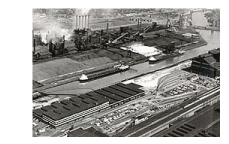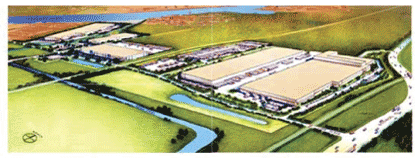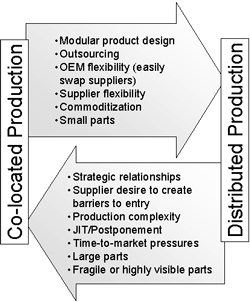|
By Bill McBeath
As supply chains become increasingly integrated and synchronized,
we are witnessing the evolution of the business/production
models (in some industries) that merge virtual integration
with elements of the older vertically integrated enterprise.
This has profound consequences, in particular for suppliers
to OEMs.
Business Integration Models: The Old and the New
Ford's River Rouge complex, the largest industrial complex
in the world during the 1920's and 30's, is often cited
as the prototypical example of vertical integration. Iron
ore came in one side and autos came out the other end.
Contrast that with the development of virtually integrated
supply chains during the 80's and 90's: thousands of suppliers
dispersed across the globe, each with their own role in
the production of a single product. But this is also changing.
I had a "back-to-the-future experience" during
a recent tour of Ford's first North American supplier park,
scheduled to start production next year. Located ½ mile
from Ford's 2.7 million square foot Chicago Assembly Plant,
the supplier park boasts another 1.6 million square feet
of manufacturing space[1] . In this combined campus, sheet
metal and other raw materials are trucked into one side
and finished autos roll out the other end … sound
familiar?

Figure 2 - Ford's Chicago Supplier Park
But this is very different than the Rouge-style vertical
integration of the past. 11 suppliers are co-located
on one campus, forming a physically integrated plant,
with
different
sections run by each different supplier[2] .
Bodies stamped out by Tower Automotive and Sanderson
Industries pass
through a huge door to have suspension systems added
by ZF-Lemforder,
fuel tanks and instrument panels by Visteon, door parts
by Brose, consoles by Summit Polymers, wiring by S-Y
Systems, molded plastics by Plastech, with automated
assembly and
tooling and equipment provided by Comau Pico. Final assembly
is done across the road at the huge Ford plant.
New Entities
What is striking here is the level of supplier commitment
and integration. These tenants have long-term (e.g. 9+
years) triple net leases (tenants pay for all maintenance
expenses, plus utilities, taxes, and insurance). Many have
put significant investments into upgrading the buildings,
and all are putting large investments into equipping these
plants with state-of-the-art manufacturing lines. For example,
Tower, in addition to a pair of massive 2,000 ton stamping
machines and hundreds of sophisticated welding robots,
has its own 30 Megawatt power substation to feed its welding
operations.
The supplier park approach takes strategic supplier relationships
to a whole new level—binding the OEM and suppliers
into a new sort of "enterprise", not in the traditional
legal sense, but through contractual and informal commitments,
agreements, and physical processes into an integrated whole.
While this is the first such supplier park in North America,
there have been similar experiments in Brazil and Europe
(Spain, Czech Republic, Sweden, Germany, and France). We
expect to see more arrangements like this, particularly in
automotive, but possibly in electronics and aerospace, which
have similar driving forces.
Key Drivers
The big drivers here are JIT production, postponement/mass
customization, and time-to-market compression. The OEMs
strive to become ever leaner, demanding ever-shorter lead
times, driving co-location of key suppliers. Mass customization,
such as the 5-day car[3],
pushes postponement further back into the chain – e.g.
waiting until you actually receive an order before painting
the body and installing
options. This won't work if there is an extra day of transportation
between suppliers. As an example of the new time frames
at the Ford supplier park, Brose will produce and deliver
a door assembly (adding wire-harnesses, speakers, window
regulators, etc.) within 120 minutes of receiving an order.
Time-to-market may be the biggest driver. Face-to-face interactions
between engineers and production personnel at the OEM and
the various suppliers allow rapid transfer of knowledge and
debugging of problems. The Internet may be great for abstract
design efforts like distributed software engineering, but
when it comes to working out the kinks in manufacturing operations,
there is nothing like walking someone over and showing them
the problem. This allows the development and continual improvement
of shared processes and practices. In addition, when suppliers
are this tightly synchronized via conveyor belts with lean
buffers, problems become apparent almost instantly and can
be corrected before many incorrect parts are produced.
High Tech Contrast
The high tech industry has not (yet) embraced the supplier
park concept, though it faces many of the same dynamics
(JIT/lean, postponement, time-to-market pressures, etc.).
High tech firms instead have A) aggressively outsourced
manufacturing to contract manufacturers and B) implemented
VMI hubs near the OEM or CM plant, typically demanding
2-4 hour lead times from the hub to enable JIT production
in their plant.
Reasons for high tech's different path include highly modularized
designs—that is highly standardized form factors and
electrical characteristics of the major components, such
as processors, memory, mass storage, motherboards, and connectors
(enclosures are somewhat of an exception). This reduces the
need for face-to-face interaction in manufacturing. Also,
the much smaller size of high tech components, compared with
automotive bodies, means transportation is not as much of
an issue. In addition, high tech OEMs have not yet pushed
postponement back to their suppliers as aggressively as in
automotive.
Different industries and different companies within an industry
evolve different approaches to supplier integration. Figure
3 illustrates some of the forces influencing the proximity
of supplies and the manufacturers they serve.

Figure 3
Of course, proximity is only one of many dimensions in a
business model. Table 1 illustrates some of the dimensions
and varieties found in supplier parks.
| Physical Linkage |
Separate buildings with buffer stocks of inventory
vs. same building with suppliers’ operations directly
linked by conveyor belts |
| Ownership, Investment, Commitment |
Supplier-owned vs. OEM-owned land and building. Varying
levels of investment by supplier, in equipment and customization
of the facility. Varying length and terms of lease. |
| Employment policies |
Unified HR policies/wages across the site vs. each
company separate. |
| Make vs. assemble |
Degree of actual manufacturing of the components vs.
final assembly. Light assembly may be done by a 3PL rather
than by the supplier. |
Table 1- Variations in Supplier Park Approaches
In the past, OEMs drove most of these relationship decisions.
But suppliers are taking an increasingly active role. As
the fate of suppliers and OEMs becomes more intertwined,
new governance models emerge that involve increased joint
decisions. OEMs are finding the benefits of strategic integration
are worth the risks of getting locked in with specific suppliers.
And suppliers are finding the benefits of the long-term strategic
relationships are worth the risk of the huge investments
they are making. We are witnessing the next big evolution
in business integration models, propelled by competitive
pressures to become leaner, faster, and more responsive.
[1]
The manufacturing floor space in the combined campuses is
the equivalent of 87 football fields!
[2]
We also see divisionalized firms evolving to the federated
models from the other direction. Shared service departments,
typically IT, must compete with outside firms for the
business of each division and additionally are allowed
to offer their services to other firms. Thus, the
shared service department becomes a highly autonomous
unit,
hard to distinguish from external suppliers.
[3]
The 5-day car goal/dream is delivering a custom configured
car within 5 days of the customer's order.
©2003
ChainLink Research, Inc.
|


